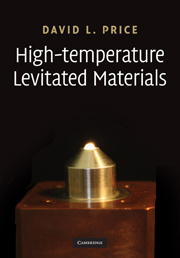6 - Liquid metals and alloys
Published online by Cambridge University Press: 23 April 2010
Summary
Since all the levitation techniques described in Chapter 2 work with conducting materials, it is not surprising that they form the subject of the majority of investigations carried out to date. In this chapter we discuss some representative systems, chosen either because several of their properties have been investigated, especially by levitation techniques, or because they exhibit especially interesting phenomena.
Early transition metals
It is convenient to divide the results obtained on levitated samples of transition metals into early (Groups IVB–VIIB) and late (Group VIIIB) transition metals. The earlier group contains the refractory metals, conventionally taken as Nb, Ta, Mo, W and Re, although relatively few measurements have been made in these even with levitation techniques, presumably because of their very high melting points. A notable exception are the early optical property measurements made on Nb by Krishnan et al. (1991a), using EML in conjunction with laser heating. Values obtained for the high-temperature solid and liquid are shown in Figs. 6.1 and 6.2. It can be seen that the values exhibit rather small discontinuities at the melting point but their temperature dependences change considerably, in the case of n and k going from small negative to large positive temperature coefficients. According to Eq. (4.26), the temperature dependence of the emissivity required a 16% correction to the previous value for the specific heat of liquid Nb at the melting point, with a revised value of 35 ± 1 J mol−1 at Tm.
- Type
- Chapter
- Information
- High-Temperature Levitated Materials , pp. 71 - 130Publisher: Cambridge University PressPrint publication year: 2010

